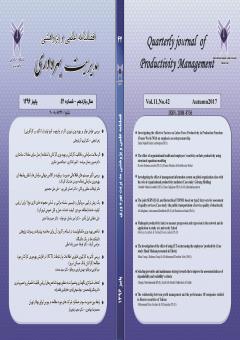The relationship between profit management and the performance Of companies studied in Bourse securities of Tehran
Subject Areas : Business Managementmohammadreza javaheri 1 , Majid Zanjirdar 2
1 - Department of Accounting,Arak Branch,Islamic Azad University,Arak,Iran
2 - Department of Accounting,Arak Branch,Islamic Azad University,Arak,Iran
Keywords: Performance, profit management, liability items,
Abstract :
Many research Findings emphasis that investors in their investments decisions will prefer smooth profit with low fluctuation. In this regards managers will try to manage the benefit and its growth. Managers either with tampering the information's for the sake of their benefit or transferring and reporting confidential information about management. The study tries to investigate the effect of benefit management by using negative correlation between the optional obligatory items change and anticipated changes of benefit. The essential performance indicators which include cash flow fund, earning per share, liability items and dividend yield have been considered and these components are considered as efficiency indicators in this research.The statistical population included all the listed companies in securities bourse in Tehran during 1384-1392. Using systematic call-off sampling method 89 companies was selected as the sample size. The results showed that there was a significant relationship between the profit management and companies performance. The profit management is also effective in forecasting future cash fund, in forcing solidarity between running and future yield.
Agnes Cheng, C. S., Johnston, J., & Shuo, L. (2014), Higher ERC or Higher Future ERC from Income Smoothing?–The Role of Information Environment. 2014 Canadian Academic Accounting Association (CAAA) Annual Conference.
Agnes Cheng, C. S., & Shuo, L. (2014), Does Income Smoothing Improve. China Accounting and Finance Rrview, 16(2), 128-147.
Ansari, A., Ansari, A., & Khajavi, H. (2011), Survey of Relationship between Income Smoothing and Stock Price and Financial Ratios. Financial Accounting Researches, 2, 33-50, (In Persian).
Badri, A. (1999), Identifying Effective Factors on Profit Smoothing. Phd Thesis, Tehran: Tehran Univercity, (In Persian).
Badri, B., & Qahraman, M. A. (2012), Income Smoothing and Cost of Equity: Evidence From Tehran Stock Exchange. Empirical Studies in Financial Accounting Quarterly, 35, 23-47, (In Persian).
Chen, H., Tang, Q., Jiang, Y., & Lin, Z. (2010), The Role of International Financial Reporting Standards in Accounting Quality: Evidence from the European Union. Journal of International Financial Management & Accounting, 21(3), 220-278.
Damoori, D., Damoori, D., Arefmanesh, Z., & Abasi Muselo, K. H. (2011), nvestigating the relation between income smoothing, earnings quality and firm value. Financial Accounting Researches, 1, 39-54, (In Persian).
Huanga, P., Zhang, Y., Deis, D. R., Moffittd, J. S. (2009), Do Artificial Income Smoothing and Real Income. Journal of Banking & Finance, 2, 224-233.
Izadinia N., Rasaiian A., & Rezaei- Rajaei, A. (2012), The Relationship of Dividend Smoothing with Corporate Governance Tools and Stock Liquidity. The Journal of Planning and Budgeting. 17(3), 53-77, (In Persian).
Kamarudin, K. A. (2006), The Impact of Cash Flows and Earnings on Dividend: Evidence from South East Asia countries. UPENA, 8, 133-160.
Kothari, S. P., Leoneb, A. J., & Wasley, Ch. E. (2005), Performance Matched Discretionary Accrual Measures. Journal of Accounting and Economics, 39(1), 163-197.
Tucker, J. W., & Zarowin, P. A. (2006), Does Income Smoothing Improve Earnings Informativeness?. The Accounting Review, 81(1), 251-270.
_||_Agnes Cheng, C. S., Johnston, J., & Shuo, L. (2014), Higher ERC or Higher Future ERC from Income Smoothing?–The Role of Information Environment. 2014 Canadian Academic Accounting Association (CAAA) Annual Conference.
Agnes Cheng, C. S., & Shuo, L. (2014), Does Income Smoothing Improve. China Accounting and Finance Rrview, 16(2), 128-147.
Ansari, A., Ansari, A., & Khajavi, H. (2011), Survey of Relationship between Income Smoothing and Stock Price and Financial Ratios. Financial Accounting Researches, 2, 33-50, (In Persian).
Badri, A. (1999), Identifying Effective Factors on Profit Smoothing. Phd Thesis, Tehran: Tehran Univercity, (In Persian).
Badri, B., & Qahraman, M. A. (2012), Income Smoothing and Cost of Equity: Evidence From Tehran Stock Exchange. Empirical Studies in Financial Accounting Quarterly, 35, 23-47, (In Persian).
Chen, H., Tang, Q., Jiang, Y., & Lin, Z. (2010), The Role of International Financial Reporting Standards in Accounting Quality: Evidence from the European Union. Journal of International Financial Management & Accounting, 21(3), 220-278.
Damoori, D., Damoori, D., Arefmanesh, Z., & Abasi Muselo, K. H. (2011), nvestigating the relation between income smoothing, earnings quality and firm value. Financial Accounting Researches, 1, 39-54, (In Persian).
Huanga, P., Zhang, Y., Deis, D. R., Moffittd, J. S. (2009), Do Artificial Income Smoothing and Real Income. Journal of Banking & Finance, 2, 224-233.
Izadinia N., Rasaiian A., & Rezaei- Rajaei, A. (2012), The Relationship of Dividend Smoothing with Corporate Governance Tools and Stock Liquidity. The Journal of Planning and Budgeting. 17(3), 53-77, (In Persian).
Kamarudin, K. A. (2006), The Impact of Cash Flows and Earnings on Dividend: Evidence from South East Asia countries. UPENA, 8, 133-160.
Kothari, S. P., Leoneb, A. J., & Wasley, Ch. E. (2005), Performance Matched Discretionary Accrual Measures. Journal of Accounting and Economics, 39(1), 163-197.
Tucker, J. W., & Zarowin, P. A. (2006), Does Income Smoothing Improve Earnings Informativeness?. The Accounting Review, 81(1), 251-270.


